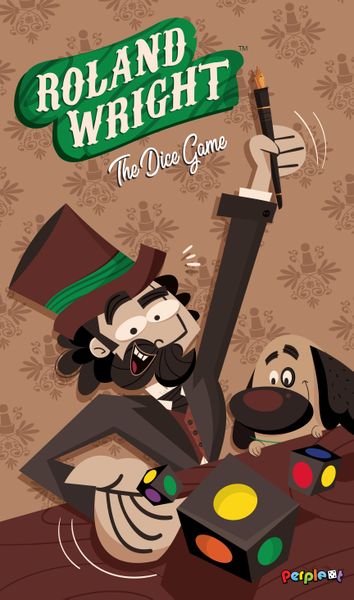Roland Wright: The Dice Game (2020) Board Game
Roland Wright: The Dice Game is a strategy board game released in 2020, designed for 1 to 5 players aged 13 and up. The game revolves around the theme of game design, where players take on the role of Roland Wright, a game designer striving to create the ultimate dice game.
Game Features
- Duration: Approximately 25 minutes per session.
- Player Count: Supports 1 to 5 players, making it suitable for both solo play and group settings.
- Components: Includes dice, player boards, and various tokens representing different game elements.
Game Components of Roland Wright: The Dice Game
- Dice: There are 6 dice featuring colored “Bits” that players roll to determine their actions each turn.
- Player Boards: Each player has a 6×6 grid board where they fill in colored Bits to complete patterns and score points.
- Color Bits: Players use colored markers or tokens to fill in the grid, representing the Bits rolled on the dice.
- Action Erasers: Players can erase certain Bits to perform specific actions, adding a strategic layer to gameplay.
- Score Tracking: Each player keeps track of their score based on the patterns completed and awards achieved during the game.
How To Setup Roland Wright: The Dice Game
- Gather Components: Ensure you have all components: 6 dice, player boards (6×6 grids), colored Bits (markers or tokens), and any additional action or equipment cards.
- Distribute Player Boards: Each player receives one player board and a set of colored Bits.
- Set Up the Dice: Place the 6 dice within reach of all players for easy access during gameplay.
- Determine the Starting Player: Choose an active player to start the game. This can be done randomly or by any agreed-upon method.
- Game Flow: The active player rolls all 6 dice.
- They group the rolled dice by color and choose one group to fill in their grid with matching Bits.
- Other players then fill in their boards based on the remaining color groups.
- Each player can perform one action by erasing a corresponding color Bit on their turn.
- End of Game:The game continues until a player fills their grid; the game ends on the next turn after this occurs. The player with the highest score wins.
Gameplay Mechanics and Game Objective
Rolling Dice: Each turn, the active player rolls 6 dice that display various colored Bits.
Grouping and Selecting: The active player groups the rolled dice by color and selects one group to keep for themselves, marking corresponding Bits on their grid.
Filling the Grid: Other players then fill in their grids based on the remaining color groups available. This requires strategic thinking about which colors will help achieve their patterns.
Performing Actions: After filling in their grids, all players can choose to erase a Bit of a specific color to perform an action, such as changing a Bit’s color or drawing new goal cards.
End Game Condition: The game continues until one player fills their grid completely. The game concludes at the end of the next round, allowing all players one final turn.
The primary objective is to score the most points by completing patterns on the grid and achieving awards based on those patterns. Points can be earned through:
- Completing specific patterns with colored Bits.
- Utilizing actions effectively to manipulate Bits and enhance scoring potential.
- Filling the entire grid, which grants bonus points.
The player with the highest score at the end of the game is declared the winner, emphasizing both strategic planning and adaptability throughout gameplay.
Player Experience
Pros
- Unique Theme: The game revolves around game design itself, allowing players to engage in a creative process while playing, which can be appealing to board game enthusiasts and designers alike.
- Strategic Depth: Players must think critically about grouping dice, selecting colors, and planning grid placements, which adds layers of strategy and decision-making.
- Variety of Actions: The ability to erase Bits for special actions provides flexibility and encourages players to adapt their strategies based on the game’s progression.
- Replayability: With different Hallmark and Equipment cards available each game, along with varying player strategies, the game offers a fresh experience every time it is played.
- Solo Play Option: The game includes a solo variant, making it accessible for players who prefer or need to play alone.
Cons
- Limited Player Interaction: While players share the same dice rolls, there is minimal direct interaction between them, which might not appeal to those who enjoy more competitive or confrontational gameplay styles.
- Complexity: Some players may find the mechanics overwhelming, particularly if they are not accustomed to heavier roll-and-write games. The need for strategic planning can deter casual gamers.
- Lengthy Turns: In multiplayer settings, turns can take longer as players deliberate over their moves, potentially slowing down the pace of the game.
- Learning Curve: New players might face a steep learning curve due to the various actions and strategies involved, which could lead to frustration during initial plays.
Personal Thoughts on Roland Wright: The Dice Game
Roland Wright: The Dice Game offers a unique blend of puzzle and dice mechanics that can be appealing to players who enjoy strategic thinking. However, the limited variability in components may hinder its replay value for some. The build quality is decent, and the pricing is reasonable for the components provided. It may be worth your time if you enjoy puzzle games with a strategic element. However, those looking for more complexity or variety may want to explore alternative games in the genre. Overall, it is suitable for those who appreciate a mix of dice-rolling and puzzle-solving mechanics.
We are supported by our audience. When you purchase through links on our site, we may earn an affiliate commission, at no extra cost for you. Learn more.

